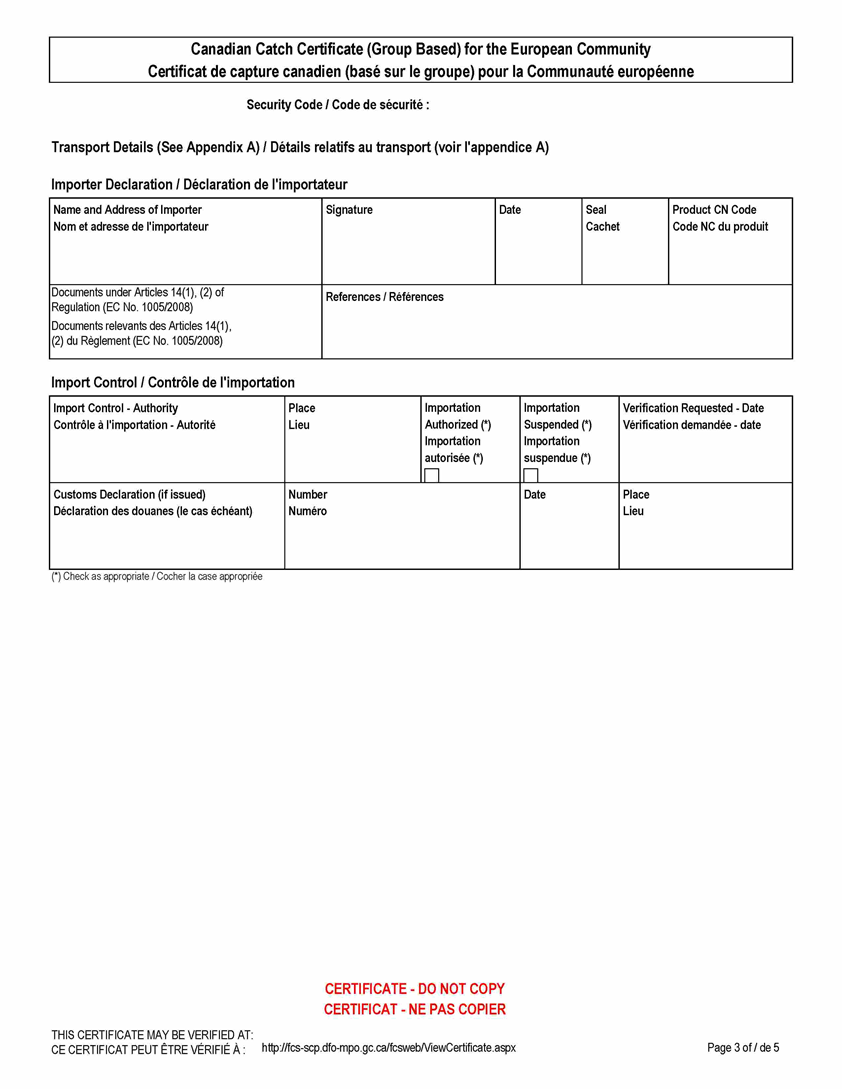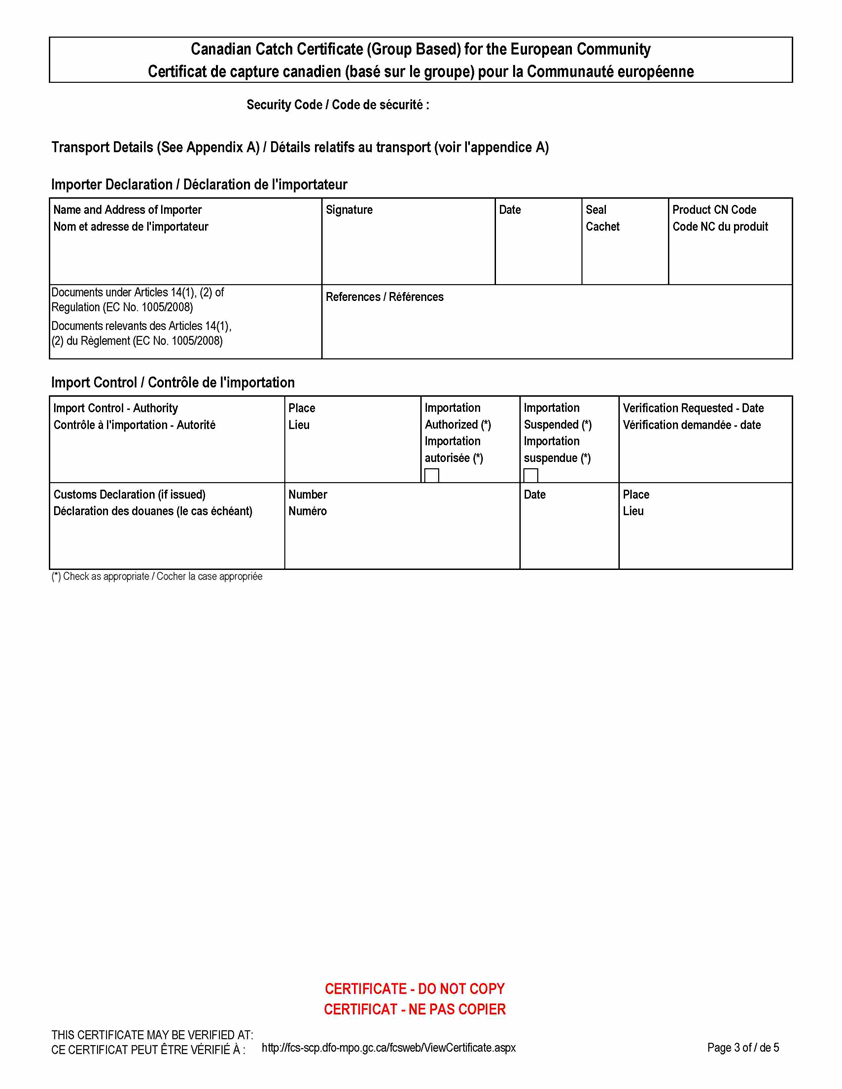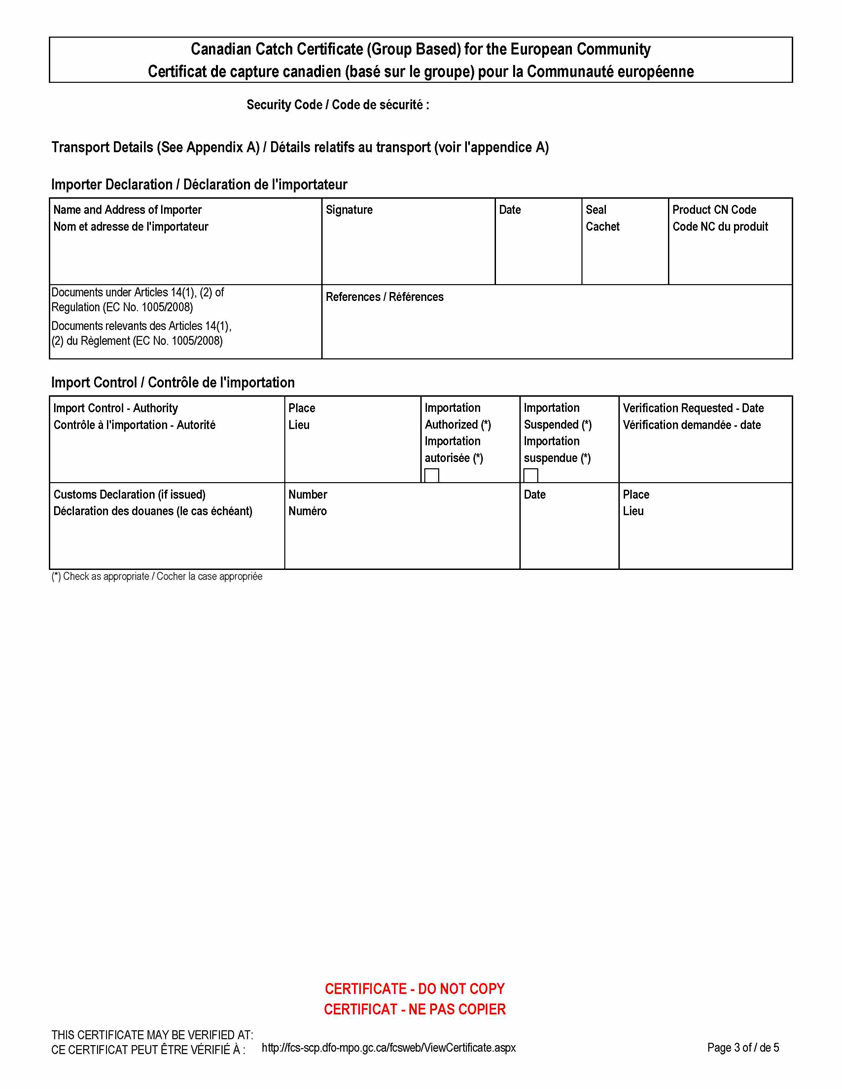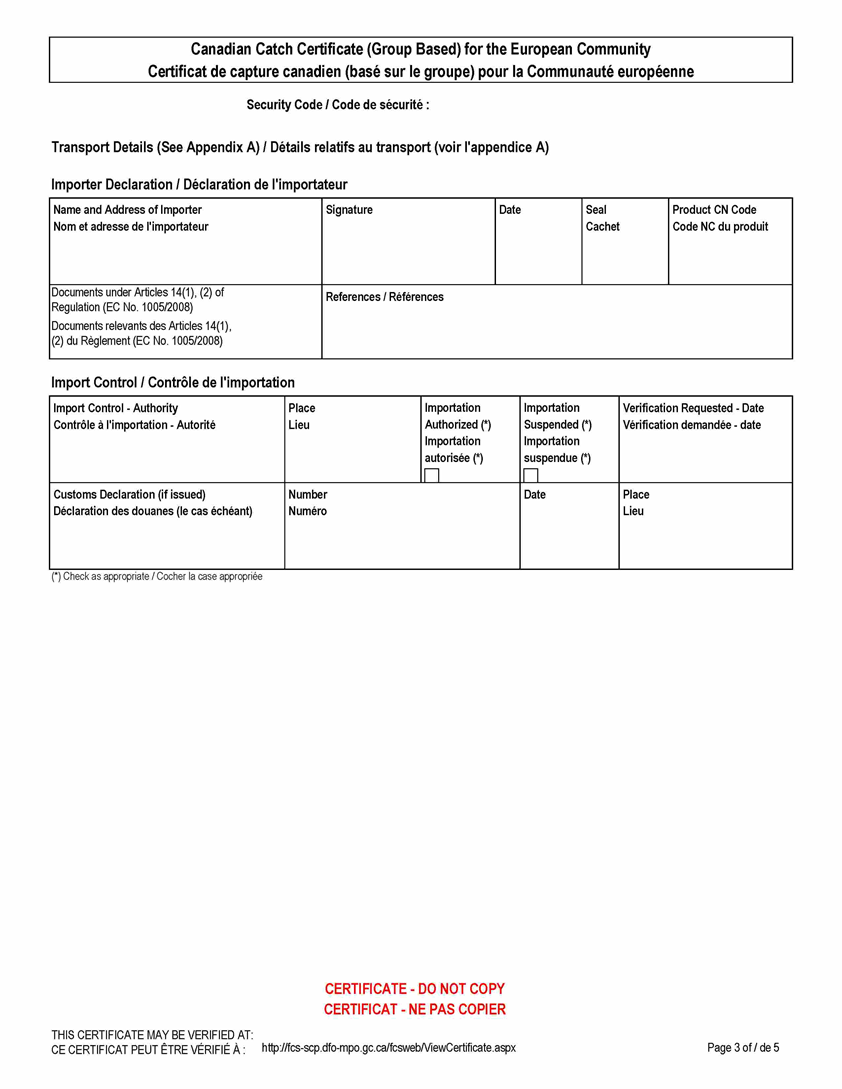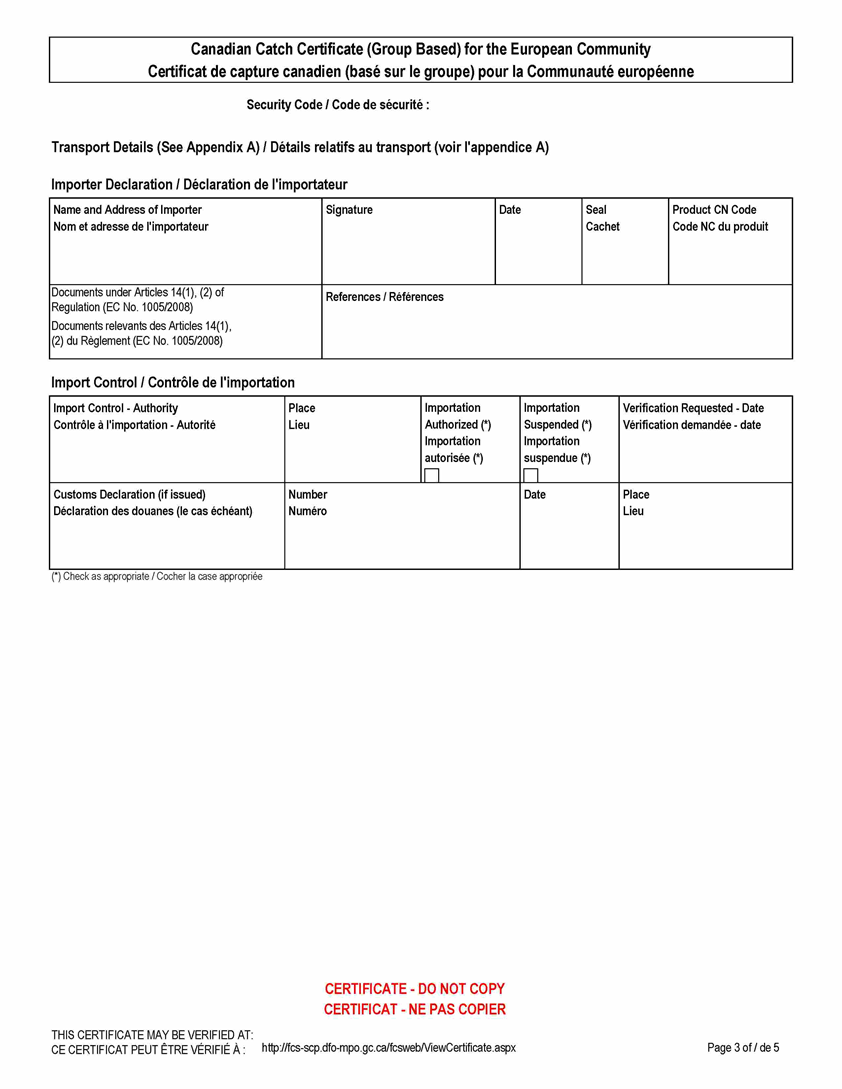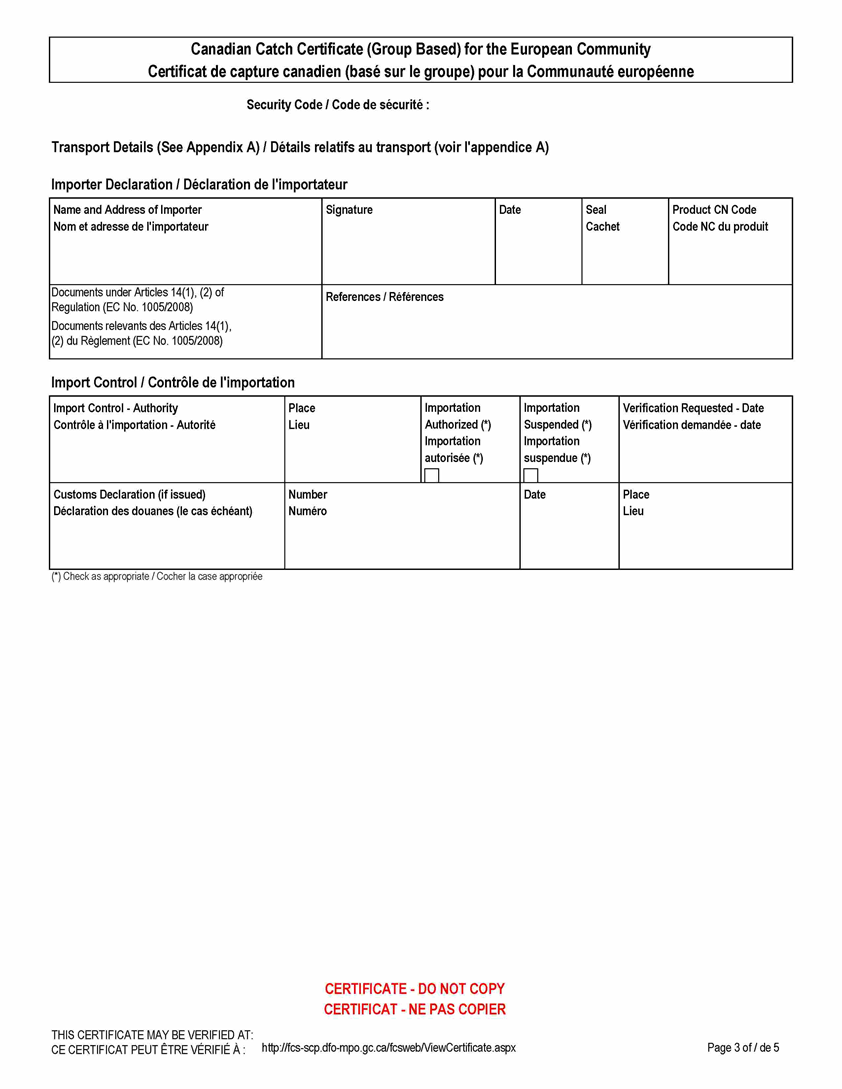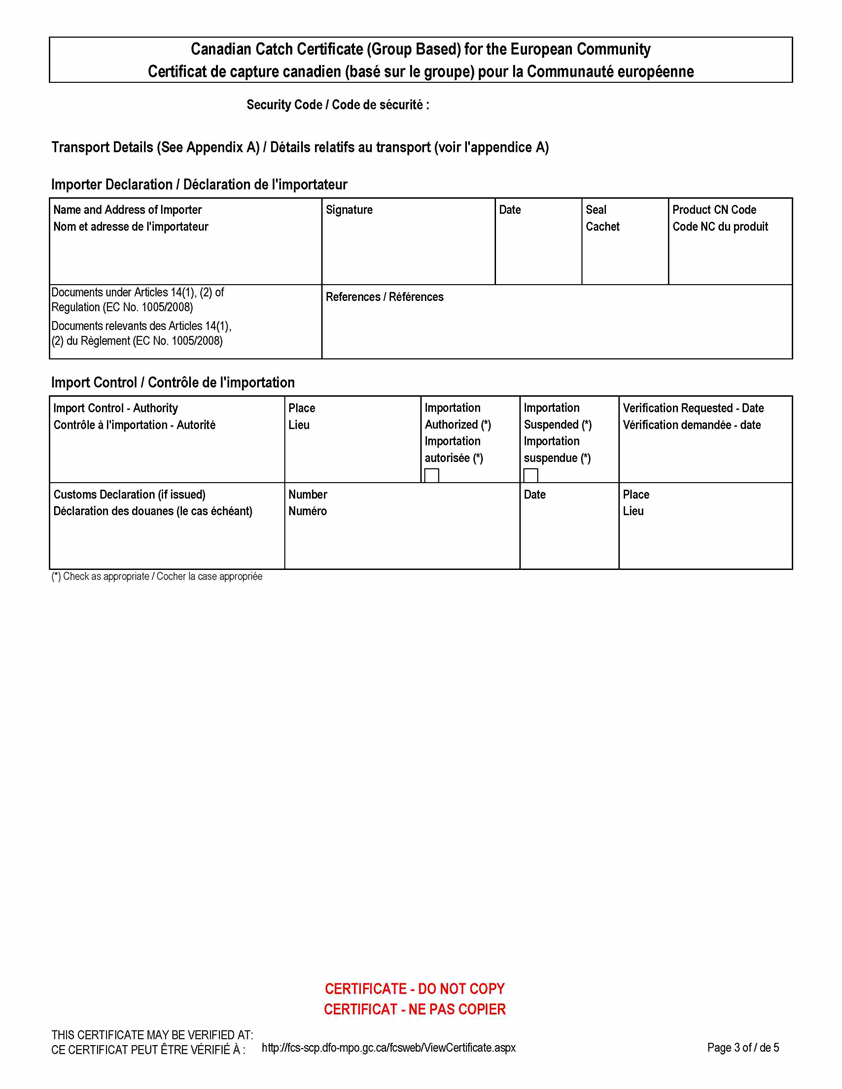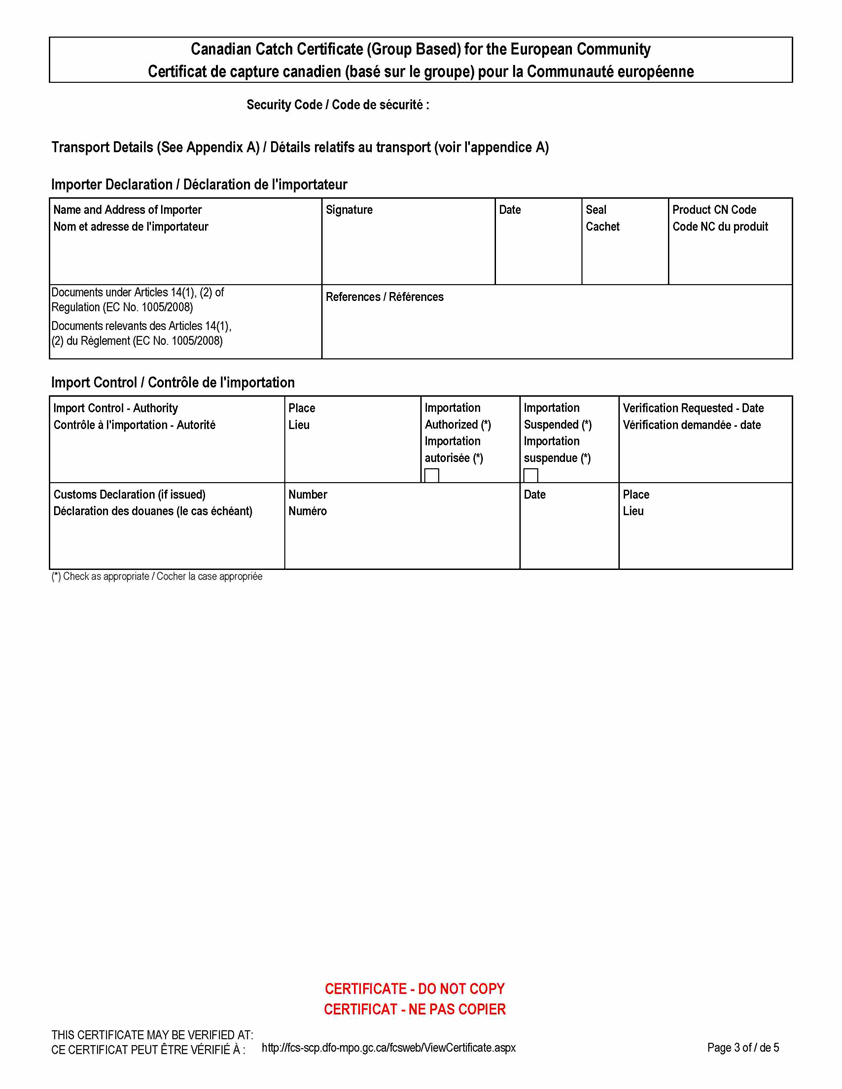- Latest available (Revised)
- Point in Time (09/03/2011)
- Original (As adopted by EU)
Commission Regulation (EC) No 1010/2009Show full title
Commission Regulation (EC) No 1010/2009 of 22 October 2009 laying down detailed rules for the implementation of Council Regulation (EC) No 1005/2008 establishing a Community system to prevent, deter and eliminate illegal, unreported and unregulated fishing
You are here:
- Regulations originating from the EU
- 2009 No. 1010
- Annexes only
- Show Geographical Extent(e.g. England, Wales, Scotland and Northern Ireland)
- Show Timeline of Changes
More Resources
Revised version PDFs
- Revised 27/03/20208.00 MB
- Revised 17/09/20137.32 MB
- Revised 01/03/20137.58 MB
- Revised 06/12/20117.26 MB
- Revised 09/03/20115.65 MB
- Revised 01/01/20105.82 MB
When the UK left the EU, legislation.gov.uk published EU legislation that had been published by the EU up to IP completion day (31 December 2020 11.00 p.m.). On legislation.gov.uk, these items of legislation are kept up-to-date with any amendments made by the UK since then.
This item of legislation originated from the EU
Legislation.gov.uk publishes the UK version. EUR-Lex publishes the EU version. The EU Exit Web Archive holds a snapshot of EUR-Lex’s version from IP completion day (31 December 2020 11.00 p.m.).
Status:
Point in time view as at 09/03/2011.
Changes to legislation:
There are currently no known outstanding effects for the Commission Regulation (EC) No 1010/2009.![]()
Changes to Legislation
Revised legislation carried on this site may not be fully up to date. At the current time any known changes or effects made by subsequent legislation have been applied to the text of the legislation you are viewing by the editorial team. Please see ‘Frequently Asked Questions’ for details regarding the timescales for which new effects are identified and recorded on this site.
ANNEX IU.K. Prior notification period for certain types of fishery products referred to in Article 1
Four-hour prior notification period U.K.
Landings of fresh fishery products by fishing vessels into designated Community ports.
[F1ANNEX IIA U.K. Form for prior notification for third country fishing vessels referred to in Article 2(1)
Textual Amendments
F1 Substituted by Commission Regulation (EU) No 202/2011 of 1 March 2011 amending Annex I to Council Regulation (EC) No 1005/2008 as regards the definition of fishery products and amending Regulation (EC) No 1010/2009 as regards prior notification templates, benchmarks for port inspections and recognised catch documentation schemes adopted by regional fisheries management organisations.
ANNEX IIB U.K. Form for prior notification for third country fishing vessels referred to in Article 2(2)]
ANNEX IIIAU.K. Form for pre-landing declarations referred to in Article 3(1)
ANNEX IIIBU.K. Form for pre-transhipment declarations referred to in Article 3(2) (required from both donor and receiving vessel)
ANNEX IVU.K. EUROPEAN COMMUNITY CATCH CERTIFICATE Simplified form for fishery products fulfilling the requirements in Article 6 of this Regulation
Appendix
Transport details U.K.
ANNEX V U.K. Catch documentation schemes adopted by regional fisheries management organisations recognised as complying with the requirements of Regulation (EC) No 1005/2008
Part ICatch documentation schemes recognised as complying with the requirements of Regulation (EC) No 1005/2008:U.K.
Dissostichus spp. catch documentation scheme as set out in Council Regulation (EC) No 1035/2001 of 22 May 2001 establishing a catch documentation scheme for Dissostichus spp(1).
[F1ICCAT Bluefin tuna Catch Documentation Programme as set out in Regulation (EU) No 640/2010 of the European Parliament and of the Council] (2)
Part IICatch documentation schemes recognised as complying with the requirements of Regulation (EC) No 1005/2008, subject to additional conditions:U.K.
CCSBT (Commission for the Conservation of Southern Bluefin Tuna) — Resolution on the implementation of a CCSBT Catch Documentation scheme (adopted at the Fifteenth Annual Meeting — 14-17 October 2008). In addition to the catch documents and any related documents validated in conformity with the CCSBT Catch Documentation scheme, the importer shall submit to the authorities of the Member States of importation the information on transport details, specified in the Appendix on transport details included in Annex II of Regulation (EC) No 1005/2008.
ANNEX VIU.K. Submission periods of catch certificates for consignments referred to in Article 8
Four-hour period for submission of catch certificate prior to entry into the Community U.K.
Consignments of fishery products entering the Community by airfreight
Two-hour period for submission of catch certificate prior to entry into the Community U.K.
Consignments of fishery products entering the Community by road
Four-hour period for submission of catch certificate prior to entry into the Community U.K.
Consignments of fishery products entering the Community by railway
ANNEX VIIU.K.
ANNEX VIIIU.K.
ANNEX IXU.K. Administrative arrangement with flag States pertaining to the implementation of the catch certification provisions (Article 12(4) of Regulation (EC) No 1005/2008)
[F2Section 1 U.K. NORWAY
CATCH CERTIFICATION SCHEME U.K.
Norway shall require a catch certificate for landings and imports to Norway of catches made by fishing vessels flying the flag of a Member State of the European Community.
In accordance with Article 12(4) of Regulation (EC) No 1005/2008, the catch certificate provided for in Article 12 and Annex II of Regulation (EC) No 1005/2008 shall, as of 1 January 2010 , be replaced — for fisheries products obtained from catches made by fishing vessels flying the flag of Norway — by a Norwegian catch certificate based on the Norwegian system of sales notes, which is an electronic traceability system under the control of the Norwegian authorities ensuring the same level of control by authorities as required under the Community catch certification scheme.
A specimen of a Norwegian catch certificate is given in the Appendix.
The Norwegian system of sales notes shall also be used to issue and validate a catch certificate for export consignments from Norway to the European Community of conventional fishery products including stock-fish, salted fish and salted and dried klippfish, using raw material from small fishing vessels and/or involving production comprising several steps in the production process, in accordance with entry 7. bis of the attached specimen.
Documents referred to in Article 14(1) and (2) of Regulation (EC) No 1005/2008 may be established, validated and submitted by electronic means.
MUTUAL ASSISTANCE U.K.
Mutual assistance under Article 51 of Regulation (EC) No 1005/2008 shall be developed to facilitate the exchange of information and administrative cooperation between respective competent authorities in Norway and the Member States of the European Community, based on detailed rules on mutual assistance laid down in Commission Regulation (EC) No 1010/2009.
Appendix U.K.
Textual Amendments
F2 Inserted by Commission Regulation (EU) No 86/2010 of 29 January 2010 amending Annex I to Council Regulation (EC) No 1005/2008 as regards the definition of fishery products and amending Commission Regulation (EC) No 1010/2009 as regards exchange of information on inspections of third country vessels and administrative arrangements on catch certificates.
Section 2 U.K. UNITED STATES
CATCH CERTIFICATION SCHEME U.K.
In accordance with Article 12(4) of Regulation (EC) No 1005/2008, the catch certificate provided in Article 12 and Annex II of Regulation (EC) No 1005/2008 shall be replaced — for fisheries products obtained from catches made by fishing vessels flying the flag of the United States — by the US catch certificate, supported by electronic reporting and record keeping systems under the control of the US authorities ensuring the same level of control by authorities as required under the Community catch certification scheme.
A specimen of the US catch certificate, which shall replace the European Community Catch Certificate and Re-export Certificate as from 1 January 2010 , is given in the Appendix.
MUTUAL ASSISTANCE U.K.
Mutual assistance under Article 51 of Regulation (EC) No 1005/2008 shall be developed to facilitate the exchange of information and administrative cooperation between respective competent authorities in the United States and Member States of the European Community, based on detailed rules on mutual assistance laid down in Commission Regulation (EC) No 1010/2009.
Appendix U.K.
Section 3 U.K. NEW ZEALAND
CATCH CERTIFICATION SCHEME U.K.
In accordance with Article 12(4) of Regulation (EC) No 1005/2008, the catch certificate provided for in Article 12 and Annex II of Regulation (EC) No 1005/2008 shall be replaced — for fisheries products obtained from catches made by fishing vessels flying the flag of New Zealand — by the New Zealand catch certificate, which is an electronic traceability and certification system under the control of the New Zealand authorities ensuring the same level of control by authorities as required under the Community catch certification scheme.
A specimen of the New Zealand catch certificate, which shall replace the European Community Catch Certificate and Re-export Certificate for catches by fishing vessels registered in New Zealand and which are landed in New Zealand from 1 January 2010 , is given in Appendix I.
Supporting explanatory notes on the New Zealand catch certificate are given in Appendix II.
Documents referred to in Article 14(1) and (2) of Regulation (EC) No 1005/2008 may be communicated by electronic means.
MUTUAL ASSISTANCE U.K.
Mutual assistance under Article 51 of Regulation (EC) No 1005/2008 shall be developed to facilitate the exchange of information and assistance between respective competent authorities in New Zealand and Member States of the European Community, based on detailed rules on mutual assistance laid down in Commission Regulation (EC) No 1010/2009.
Appendix I U.K.
Specimen of the New Zealand catch certificate U.K.
Appendix II U.K.
Supporting explanatory notes on the New Zealand catch certificate U.K.
The ‘ consignor ’ is the ‘ exporter ’
Any information included in an ‘ unofficial information ’ box and information that follows the New Zealand government signatures is not validated by the New Zealand government.
[F3Section 4 U.K. ICELAND
CATCH CERTIFICATION SCHEME U.K.
In accordance with Article 12(4) of Regulation (EC) No 1005/2008, the catch certificate provided for in Article 12 and Annex II to that Regulation shall, as of 1 January 2010 , be replaced — for fisheries products obtained from catches made by fishing vessels flying the Icelandic flag — by the Icelandic catch certificate, based on the Icelandic System on weighing and recording of catches, which is an electronic traceability system under the control of the Icelandic authorities ensuring the same level of control by authorities as required under the EU catch certification scheme.
A specimen of the Icelandic catch certificate is given in the Appendix.
Documents referred to in Article 14(1) and (2) of Regulation (EC) No 1005/2008 may be communicated by electronic means.
Iceland shall require a catch certificate for landings and imports to Iceland of catches made by fishing vessels flying the flag of a Member State of the European Union.
MUTUAL ASSISTANCE U.K.
Mutual assistance pursuant to Article 51 of Regulation (EC) No 1005/2008 shall be developed to facilitate the exchange of information and the assistance between the respective authorities in Iceland and in the Member States of the European Union, based on the detailed rules on mutual assistance laid down in Commission Regulation (EC) No 1010/2009.
Appendix U.K.
Textual Amendments
Section 5 U.K. CANADA
CATCH CERTIFICATION SCHEME U.K.
In accordance with Article 12(4) of Council Regulation (EC) No 1005/2008, the catch certificate provided for in Article 12 and Annex II to that Regulation shall be replaced — for fisheries products obtained from catches made by fishing vessels flying the flag of Canada — by Canadian catch certificates based on the Canadian Fisheries Certificate System (FCS) (described in Appendix 3), which is an electronic traceability system under the control of the Canadian authorities ensuring the same level of control by authorities as required under the EU catch certification scheme.
Specimens of the Canadian catch certificates which shall replace the European Community Catch Certificate and Re-export Certificate as from 1 January 2010 are given in Appendices 1 and 2.
Catches stemming from aboriginal fishing techniques or from fishing vessels as defined in Article 6 of Commission Regulation (EC) No 1010/2009 shall be accompanied by a simplified Canadian catch certificate given in Appendix 2.
Documents referred to in Article 14(1) and (2) of Regulation (EC) No 1005/2008 may be communicated by electronic means.
MUTUAL ASSISTANCE U.K.
Mutual assistance pursuant to Article 51 of Regulation (EC) No 1005/2008 shall be developed to facilitate the exchange of information and administrative cooperation between respective competent authorities in Canada and Member States of the European Union, based on detailed rules on mutual assistance laid down in Commission Regulation (EC) No 1010/2009.
Appendix 1 U.K.
Appendix 2 U.K.
Appendix 3 U.K.
The Canadian Fisheries Certificate System (FCS) is designed to issue standard and simplified catch certificates. U.K.
The FCS will be used to issue and to validate a catch certificate for export consignments from Canada to the European Union of conventional fishery products including live, fresh, frozen, salted, canned and/or smoked and dried fish, using raw material from non-vessel fisheries, aboriginal fisheries, or small and large fishing vessels and/or involving production comprising several steps in the production process.
On simplified certificates, Canada will group certain vessels to maximise efficiency. However, the FCS will maintain a complete link to vessels contained in groupings and these vessels are further linked to their license or registration information and the declared catch on the certificate.
The grouping feature will be used for some product forms and, in particular, for fisheries using collector vessels which purchase from several fishing vessels and issue records of sales at sea, for non-vessel fisheries such as beach seine, beach clams, ice fishing, for some inshore fisheries, and for aboriginal fisheries where fisheries may occur at the community level. Groupings will be export company-specific and will be modified for each shipment, as required.
The grouping feature will enable Canada to produce a single certificate per shipment while keeping all the information behind the certificate (vessel license/registration) available in the database.
This information will be available to EU Member States authorities in importing countries through our website or through direct telephone line to our certificate office.
Third parties countries may also contact the certificate office for information on indirect exports.
Section 6 U.K. FAROE ISLANDS
CATCH CERTIFICATION SCHEME U.K.
In accordance with Article 12(4) of Regulation (EC) No 1005/2008, the catch certificate provided for in Article 12 and Annex II to that Regulation shall be replaced — for fisheries products obtained from catches made by fishing vessels flying the Faroese flag — by the Faroese catch certificate based on the Faroese system of sales notes and logbooks which is a traceability system under the control of the Faroese authorities ensuring the same level of control by authorities as required under the EU catch certification scheme.
A specimen of the Faroese catch certificate, which shall replace the European Community Catch Certificates and Re-export Certificate as from 1 January 2010 , is given in the Appendix.
Documents referred to in Article 14(1) and (2) of Regulation (EC) No 1005/2008 may be communicated by electronic means.
MUTUAL ASSISTANCE U.K.
Mutual assistance pursuant to Article 51 of Regulation (EC) No 1005/2008 shall be developed to facilitate the exchange of information and assistance between respective competent authorities of the Faroe Islands and Member States of the European Union, based on detailed rules on mutual assistance laid down in Commission Regulation (EC) No 1010/2009.
Appendix] ] U.K.
ANNEX XAU.K. Form for submission of information regarding sighted fishing vessels
ANNEX XBU.K. Instructions for filling the format set out in Annex XA
FILL IN AS MUCH INFORMATION AS POSSIBLEU.K.
1.Vessel name, call sign, flag and if possible registration and Lloyd IMO number are to be obtained from what is seen on the vessel or from radio contact with the vessels (the source of this information must be reported).U.K.
2.Distinguishing markings: state whether the name and port of registration of the vessel was visible or not. Record hull and superstructure colours, number of masts, position of bridge and funnel length, etc.U.K.
3.Type of vessel: describe the type of vessel and gear sighted (e.g. longliner, trawler, factory ship, carrier ship).U.K.
4.Position: record the initial sighting of the vessel, including fishing area/subarea/division.U.K.
5.Activity of the sighted vessel: record the time of the sighting, activity of the vessel at that time and heading (degrees). Record whether the vessel was fishing, setting fishing gear, trawling, hauling or other activities. Space is available for up to five sightings of the same vessel, if more space is needed complete this section on the back of the form or on a separate sheet of paper. Record presence/absence of a streamer line.U.K.
6.Record of sighting: indicate if the sighting of the vessel was recorded on video or with photographs (record where documents have been deposited under comments).U.K.
7.Comments: indicate the direction in which the vessel was transiting. Summarise any radio conversation that took place with indication of the name, nationality, position given by the person(s) contacted on board of the sighted vessel.U.K.
8.Diagram of vessel: draw the profile of the vessel, indicating any distinguishing markings that could be used for identification.U.K.
ANNEX XIU.K. Standard form for the exchange of information on request according to Article 45
ANNEX XIIU.K. Standard form for the request for administrative notification according to Article 48
F4ANNEX XIIIU.K. [F4List of products excluded from the definition of ‘ fishery products ’ set out in point 8 of Article 2 of Council Regulation (EC) No 1005/2008 of 29 September 2008 establishing a Community system to prevent, deter and eliminate illegal, unreported and unregulated fishing]
Textual Amendments
F4 Deleted by Commission Regulation (EU) No 202/2011 of 1 March 2011 amending Annex I to Council Regulation (EC) No 1005/2008 as regards the definition of fishery products and amending Regulation (EC) No 1010/2009 as regards prior notification templates, benchmarks for port inspections and recognised catch documentation schemes adopted by regional fisheries management organisations.
[ F4. . . . . . . . . . . . . . . . . . . . . . . . . . . . . . . .]
Textual Amendments
F1 Substituted by Commission Regulation (EU) No 202/2011 of 1 March 2011 amending Annex I to Council Regulation (EC) No 1005/2008 as regards the definition of fishery products and amending Regulation (EC) No 1010/2009 as regards prior notification templates, benchmarks for port inspections and recognised catch documentation schemes adopted by regional fisheries management organisations.
Options/Help
Print Options
PrintThe Whole Regulation
PrintThe Annexes only
Legislation is available in different versions:
Latest Available (revised):The latest available updated version of the legislation incorporating changes made by subsequent legislation and applied by our editorial team. Changes we have not yet applied to the text, can be found in the ‘Changes to Legislation’ area.
Original (As adopted by EU): The original version of the legislation as it stood when it was first adopted in the EU. No changes have been applied to the text.
Point in Time: This becomes available after navigating to view revised legislation as it stood at a certain point in time via Advanced Features > Show Timeline of Changes or via a point in time advanced search.
See additional information alongside the content
Geographical Extent: Indicates the geographical area that this provision applies to. For further information see ‘Frequently Asked Questions’.
Show Timeline of Changes: See how this legislation has or could change over time. Turning this feature on will show extra navigation options to go to these specific points in time. Return to the latest available version by using the controls above in the What Version box.
More Resources
Access essential accompanying documents and information for this legislation item from this tab. Dependent on the legislation item being viewed this may include:
- the original print PDF of the as adopted version that was used for the EU Official Journal
- lists of changes made by and/or affecting this legislation item
- all formats of all associated documents
- correction slips
- links to related legislation and further information resources
Timeline of Changes
This timeline shows the different versions taken from EUR-Lex before exit day and during the implementation period as well as any subsequent versions created after the implementation period as a result of changes made by UK legislation.
The dates for the EU versions are taken from the document dates on EUR-Lex and may not always coincide with when the changes came into force for the document.
For any versions created after the implementation period as a result of changes made by UK legislation the date will coincide with the earliest date on which the change (e.g an insertion, a repeal or a substitution) that was applied came into force. For further information see our guide to revised legislation on Understanding Legislation.
More Resources
Use this menu to access essential accompanying documents and information for this legislation item. Dependent on the legislation item being viewed this may include:
- the original print PDF of the as adopted version that was used for the print copy
- correction slips
Click 'View More' or select 'More Resources' tab for additional information including:
- lists of changes made by and/or affecting this legislation item
- confers power and blanket amendment details
- all formats of all associated documents
- links to related legislation and further information resources

